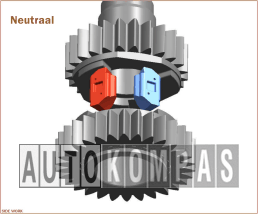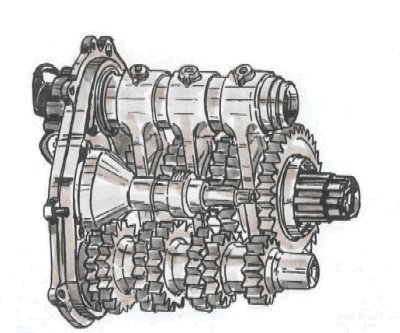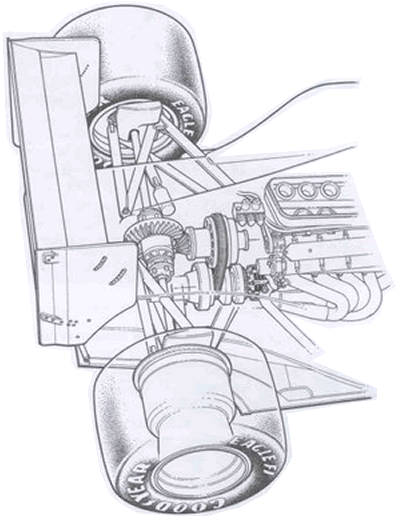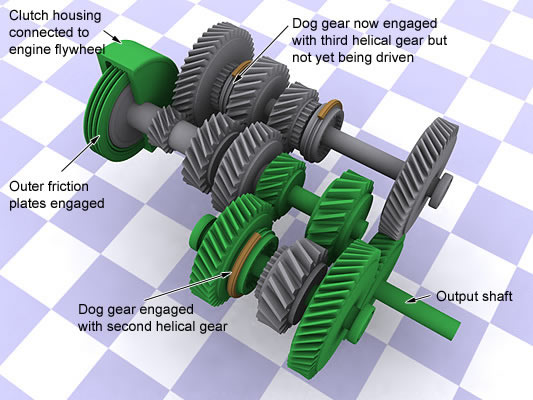Seamless gearbox
In a racing gearbox, drive is transmitted from the input shaft (direct from the engine) via toothed dog rings that sit between the gear pairs and are moved from one gear to another by the selector fork. Owing to the speed of the differential, the power has to be interrupted while the dogs disengage from one set of gears and bind with the next.
You do that by backing off the throttle (in F1, the electronics cut the ignition briefly). Even so, the torque surge as the engine moves almost instantaneously to a lower part of the rev range puts a strain on the gearbox internals and can actually break driveshafts, especially if the rear wheels are oscillating – such as happens if the driver changes gear on a corner rumble strip or over bumps.
The dynamic torque peaks during a gear change can be 10 times the static torque; if the timing is out and is not PERFECT, those forces can chip or strip the teeth of the dog and gear rings. And, as teams seek to shave fractions of a second from the shift time, the risks increase.
Why go to all this trouble to minimize those final few milliseconds in which the car isn't accelerating at full power? Because it isn't only not accelerating: during that fraction of a second when power isn't being sent to the wheels, the aero drag is so great that the car is actually decelerating. Don't forget that drag of an F1 car is somewhere between 0,65 to 0,85 Cx (road cars – below 0,30Cx). The effect only increases as the speed (and therefore the downforce generated by the wings) rises. Drag is rising with square of speed!!! It means that during a shift, say, from sixth to seventh the transient deceleration is equivalent to braking hard enough to lock the wheels of a high-end road-going sports car.
So the holy grail of the perfect gearbox is to replace the dog rings with something else – something that selects the next gear before the current one is disengaged, and which can dissipate the enormous transient torque forces and inertia that are unleashed. The reason for that vague description of "something else" is because every team running a seamless (sequential)-shift gearbox has developed its own closely guarded secret solution to the problem and, therefore, because they're all different and all ultra-clever pieces of mechanical engineering, none of the technical personnel was willing to go into detail.
"I can't even show you how a hypothetical system might work, because they're all different and it's a very technically sensitive issue," said one F1 engineer. "In effect, you've got to have some sort of compliance in there. Something that doesn't oscillate or would lead to other problems."
A shock absorber, in other words.
The obvious solution would be to have two clutches, enabling you to engage two gears at once and use software-controlled clutch-slip to synchronize the output speeds. But that has significant packaging implications (the bigger the gearbox, the less freedom there is to optimize the airflow around the diffuser and other rear-end aero devices). It also relies on flawless electronics and software; one tiny miscalculation and you could have a catastrophic breakage. Since work started on seamless-shift gearboxes, twin clutches have been banned, anyway, on the grounds that they would constitute a continuously variable transmission (CVT), which is forbidden under F1's technical regulations. And here's another gray area: a truly seamless gearbox may be deemed a CVT even though it still has between seven or eighth discrete forward gears (maximum 7 explicitly stipulated by FIA regulations until 2013, and 8 gears after big rule revision for 2014).
Anyway, after careful deliberation the FIA gave seamless-shift technology its blessing at the beginning of 2005. The best of these 'boxes are now no larger than the non-seamless variety and only marginally heavier. They still have 8 gears.
Some teams got there quicker than others: Williams, for instance, introduced it few years ago to such effect that it was able to land a Toyota engine supply deal by offering the technology in exchange. Honda also cracked it quickly. BMW Sauber, however, had a number of breakages in off-season testing and only just managed to make its 'box relatively bulletproof in time for the opening race of 2007. Red Bull was also breaking drive shafts or losing gears throughout this 2007 season.
Very simple kind of Seamless gearshift is developed by "Zeroshift" for use in road cars for now, but they are developing it very fast. The 'Zeroshift' gearbox is a new 'box that promises clutchless upshifts just by slamming from one gear into the next without even lifting off the power.
It's been a dream of engineers for many years.


Zeroshift seamless gearshift
F1 engineer are never satisfied (that's why they are F1 engineers), and they started to think about seamless gearshift.
Despite the systems having been in use for several years, there is still little information coming from the teams on how they work. What is known is that the systems retain the conventional two-shaft gearbox and single clutch.

Sequential gearbox internals
Where the seamless gearbox differs is in the dog rings. Also, the system relies on two shifting barrels, not one as before. One operates first, third, fifth and seventh gear, and the other second, fourth, sixth and eight gear. To achieve a seamless gearchange we essentially engage two gears at once by moving separate barrels and rely on the fact that it takes a finite time, just a few milliseconds, before both gears would actually engage and lock the gearbox with disastrous results. In this very short period we have to disengage the previous drive gear to ensure such catastrophe. It sound complex, and indeed, it is. It fundamentally depend on knowing the precise position of the dogs in the shaft. Bear in mind that modern seamless gearbox can shift in 2 - 3 milliseconds. This is complicated with the facts that barrel shaft is not only turning in many RPM-s, but is also flexing. It is the process of sensing and recording positions of each gear in the ECU that is known as "learning" the gears.
The concept of the seamless-shift gearbox is that one gear can be engaged and the next gear can be pre-engaged ready for the shift. Thought everybody calls it seamless, it suppose to have some time between gears are actually changed. Really seamless gearbox may be deemed as CVT and banned by FIA even though it still has eight discrete forward gears (explicitly stipulated by FIA regulations).
 |
Illegal CVT gearbox fitted on Williams FW15 back side. It was banned by FIA |
When driver select new gear (up or down), two things happen in same moment. Selecting new desired gear and deselecting previous gear. Electronics and onboard computers of most sophisticated gearboxes, like Williams, Ferrari or McLaren, can predict what is next possibility for next selection, calculated by acceleration, revs of motor and wheels and all sort of other data, and perform some of calculations in advance and prepare the system for next action. That is why all teams except McLaren are so worried because of new common ECU. All electronics and controls around this 'box's should work a lot faster then on previous version. Sensors which measure positions of different movable parts must be more precise and calculations faster. A smallest miscalculation and you could have a problem.
As the system changes only the relatively small dog rings, the weight penalty for seamless gearbox is as low as 1.5kg. The weight penalty is small the lap time gain is significant - depending on the circuit, the car can gain as much a 0.2-0.3 seconds from not losing so much drive between shifts.
How it work in pictures
In first gear
In second gear
During MotoGP season 2013, Honda introduced, with great sucess, a seamless gearbox at the begining of the year. Before a race at Misano, Jorge Lorenzo and Valentino Rossi have made repeated calls for Yamaha to incorporate the technology in order to close the gap to Honda.
"When I tried it (the seamless gearbox) in Brno I was smiling because it was nice not to feel this drop in power (during gear changes)," Lorenzo said. "With a normal gearbox the bike moves every time you shift; with the seamless you can't feel it, it should save tires and also you're more in control."
Valentini Rossi: "For sure it is important, a big help for the rider - and also here at Misano is a track where you use the gearbox a lot so we hope it can be a good advantage in trying to fight with the Hondas".
The new transmission is supposed to bring Yamaha prototypes in line with the Repsol Honda machinery. The shifting performance improved dramatically for Yamaha, as the tests in Brno apparently showed, but the new gearbox is still shifting slower than Honda's.
ARTICLE 9 : TRANSMISSION SYSTEM
9.1 Transmission types :
No transmission system may permit more than two wheels to be driven.
9.2 Clutch control :
The following applies only to the main drivetrain clutch or clutches, any clutch used exclusively as part of an ERS is exempt.
9.2.1 If multiple clutch operating devices are used, they must all have the same mechanical travel characteristics and be mapped identically.
9.2.2 Designs which allow specific points along the travel range of the clutch operating device to be identified by the driver or assist him to hold a position are not permitted.
9.2.3 The minimum and maximum travel positions of the clutch operating device must correspond to the clutch fully engaged normal rest position and fully disengaged (incapable of transmitting any useable torque) positions respectively.
9.2.4 Designs or systems which in addition to typical inherent hydraulic and mechanical properties are designed to, or have the effect of, adjusting or otherwise influencing the amount, or rate, of engagement being demanded by the FIA ECU, are not permitted.
9.2.5 The amount by which the clutch is engaged must be controlled solely and directly by the driver with the exception of : a) Stall prevention. b) Gearshifts. c) Bite point finder where brake pressure, wheel speed and driver clutch demand safeguards are used. d) De-clutch protections. e) Drivetrain protection on the track outside of any start lockout period or immediately following stall prevention activation only. f) Test signals enabled only when the car is connected to the garage system. The relationship between the clutch operating device in the cockpit and the amount of clutch engagement may be non-linear but must remain fixed.
9.2.6 When the clutch operating device is released from its maximum travel position it must return to its resting position within 50ms. The maximum delay allowed, computed from the respective positions as recorded by the ADR or ECU, between the clutch driver control input signal and the corresponding output demand being achieved is 50ms.
9.2.7 Any device or system which notifies the driver of the amount of clutch slip or engagement is not permitted.
9.3 Traction control :
No car may be equipped with a system or device which is capable of preventing the driven wheels from spinning under power or of compensating for excessive torque demand by the driver. Any device or system which notifies the driver of the onset of wheel spin is not permitted.
9.4 Clutch disengagement :
All cars must be fitted with a means of disengaging the clutch for a minimum of fifteen minutes in the event of the car coming to rest with the engine stopped. This system must be in working order throughout the Event even if the main hydraulic, pneumatic or electrical systems on the car have failed. This system must also disconnect any ERS system fitted to the car. In order that the driver or a marshal may activate the system in less than five seconds, the switch or button which operates it must :
a) Face upwards and be recessed into the top of the survival cell no more than 150mm from the car centre line.
b) Be designed in order that a marshal is unable to accidentally re-engage the clutch.
c) Be less than 150mm from the front of the cockpit opening.
d) Be marked with a letter "N" in red at least 40mm tall, with a line thickness of at least 4mm, inside a white circle of at least 50mm diameter with a red edge with a line thickness of at least 2mm.
9.5 Gearboxes :
9.5.1 A gearbox is defined as all the parts in the drive line which transfer torque from the power unit output shaft, as described in Article 5.3.2, to the drive shafts (the drive shafts being defined as those components which transfer drive torque from the sprung mass to the un-sprung mass). It includes all components whose primary purpose is for the transmission of power or mechanical selection of gears, bearings associated with these components and the casing in which they are housed.
9.5.2 In this context the following parts are not considered part of the gearbox and may be changed without incurring a penalty under the F1 Sporting Regulations. If changing any of these parts involves breaking an FIA applied seal this may be done but must be carried out under FIA supervision :
a) The clutch assembly and the power unit output shaft, provided this is located prior to any mechanical speed reduction from the engine.
b) The clutch actuator and clutch release bearing(s).
c) Inboard driveshaft joints and seals but not their housing if that housing is integral with the gearbox output shaft and therefore part of the sprung mass.
d) The hydraulic system prior to the point at which it produces direct mechanical movement of the gear selection mechanism by means of hydraulic actuator(s).
e) Oil, oil pumps, oil filters, oil seals, oil coolers and any associated hoses or pipes.
f) Electrical sensors, actuators, servo valves and wiring.
g) Any parts associated with the suspension or functioning of the sprung suspension that are attached to the gearbox casing.
h) The rear impact structure provided it can be separated from any gearbox casing.
i) Any other component mounted to the casing whose primary purpose is unconnected with the transmission of power or selection of gears.
9.6 Gear ratios :
9.6.1 The number of forward gear ratios must be 8.
9.6.2 Each competitor must nominate the forward gear ratios (calculated from engine crankshaft to drive shafts) to be employed within their gearbox. These nominations must be declared to the FIA technical delegate at or before the first Event of the Championship. For 2014 only a competitor may re-nominate these ratios once within the Championship season, in which case the original nomination becomes immediately void, except for the continued use of used gearboxes (according to Article 28.6 of the 2014 Sporting Regulations) for the first and second practice sessions of an Event. Ratio re-nominations must be declared as a set.
9.6.3 No forward gear ratio pair may be :
a) Less than 12mm wide when measured across the gear tooth at the root diameter or any point 1mm above or below the root diameter. Above this area each side of the gear teeth may be chamfered by a maximum of 10˚. In addition, a chamfer or radius not exceeding 2.0mm may be applied to the sides and the tip of the teeth.
b) Less than 85mm between centres.
c) Less than 600g in weight (excluding any integral shaft or collar). If an integral shaft or collar is to be excluded the mass of this may be shown by calculation assuming the gear to be 12mm wide and the shaft geometry to be the same as that where slide on gears are used.
9.6.4 Gear ratios must be made from steel.
9.6.5 Continuously variable transmission systems are not permitted to transmit the power of the power unit defined in Article 5.1. 9.7 Reverse gear : All cars must be able to be driven in reverse by the driver at any time during the Event.
9.8 Gear changing :
9.8.1 Automatic gear changes are considered a driver aid and are therefore not permitted. For the purposes of gear changing, the clutch and power unit torque need not be under the control of the driver.
9.8.2 Gear changing is restricted during the following periods : One gear change is permitted after the race has started and before the car speed has reached 80km/h, provided every gear fitted to the car is capable of achieving at least 80km/h at 15,000rpm.
9.8.3 The minimum possible gear the driver is able to select must remain fixed whilst the car is moving. Each individual gear change must be separately initiated by the driver and, within the mechanical constraints of the gearbox; the requested gear must be engaged immediately unless over-rev protection is used to reject the gear shift request. Once a gear change request has been accepted no further requests may be accepted until the first gear change has been completed. Multiple gear changes may only be made under Article 5.22 or when a shift to gearbox neutral is made following a request from the driver. If an over-rev protection strategy is used this may only prevent engagement of the target gear, it must not induce a delay greater than 50ms. If a gear change is refused in this way, engagement may only follow a new and separate request made by the driver. Any de-bounce time used to condition driver gear change requests must be fixed.
9.8.4 The maximum permitted duration for down changes and up changes is 300ms and 200ms respectively. The maximum permitted delay for the latter is 80ms from the time of the driver request to the original gear being disengaged. The duration of a gear change is defined as the time from the request being made to the point at which all gear change processes are terminated. If for any reason the gear change cannot be completed in that time the car must be left in neutral or the original gear.
9.8.5 Distance channel or track position is not considered an acceptable input to gearbox control.
9.9 Torque transfer systems :
9.9.1 Any system or device the design of which is capable of transferring or diverting torque from a slower to a faster rotating wheel is not permitted.
9.9.2 Any device which is capable of transferring torque between the principal axes of rotation of the two front wheels is prohibited.
Back to the top of the page








